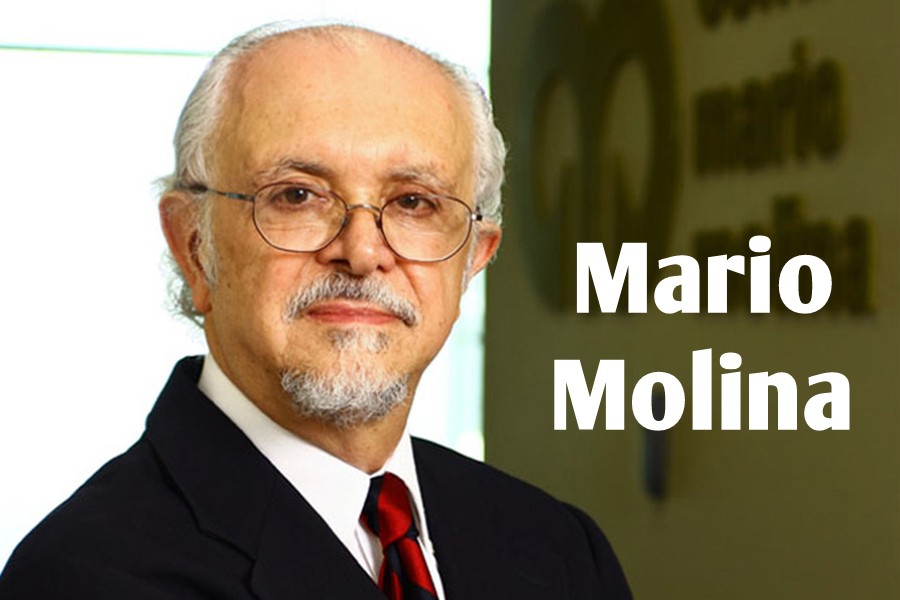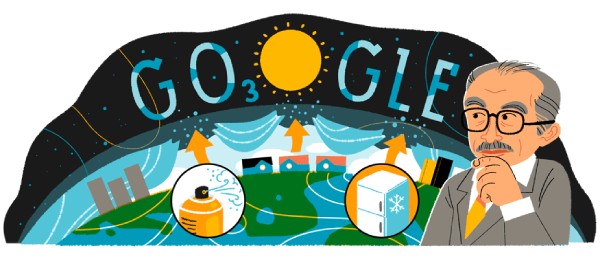Festivals & Events
Interesting Facts about Mario Molina, Mexican chemist, and Nobel Prize winner

Search engine giant Google released a Doodle on March 19, 2023, to celebrate the 80th birthday of Mexican chemist Mario José Molina Henríquez, who won the Nobel Prize for “Discovering the Threat to Earth’s Ozone Layer from CFC Gases.” Here are some interesting and fun facts about Mario Molina.

Here is a look at the life and work of Mario Molina.
Who was Mario Molina?
Personal
- Birth name: Mario José Molina Henríquez
- Birth date: 19 March 1943
- Birthplace: Mexico City, Mexico
- Died on: 7 October 2020 (aged 77)
- Death place: Mexico City, Mexico
- Education:
- National Autonomous University of Mexico (BS)
- University of Freiburg (MS)
- University of California, Berkeley (Ph.D.)
- Also Known As: Mario José Molina-Pasquel Henríquez
- Father name: Roberto Molina-Pasquel
- Mother name: Leonor Henríquez
- Spouses:
- Luisa Tan (m. 1973; div. 2005)
- Guadalupe Alvarez (m. 2006)
- Awards:
- Tyler Prize for Environmental Achievement (1983)
- Newcomb Cleveland Prize (1987)
- NASA Exceptional Scientific Achievement Medal (1989)
- Nobel Prize in Chemistry (1995)
- Willard Gibbs Award(1998)
- UN Environment Programme Sasakawa Environment Prize (1999)
- Heinz Award in the Environment (2003)
- Volvo Environment Prize (2004)
- Presidential Medal of Freedom (2013)
35 Interesting and Amazing Fun Facts about Mario Molina
- Roberto Molina Pasquel, a diplomat, and Leonor Henríquez were Mario J. Molina’s parents. Mario was born on March 19, 1943, and he grew up close to his paternal aunt Esther Molina, whose work left a lasting impression on him.
- Mario Molina was a curious child who showed a predisposition to learning about science at a young age. In their New Mexico City home, Esther assisted him in setting up a laboratory in a bathroom that was rarely used and encouraged him to observe the world around him.
- He attended the “Institut auf dem Rosenberg” in Switzerland at the tender age of eleven after receiving his elementary education from schools in his native city. Molina followed the family tradition of allowing her children to study abroad for a brief period of time.
- Mario Molina went back to Mexico and went to the “National Autonomous University of Mexico” to study chemical engineering. In 1965, he earned his bachelor’s degree with distinction from the institute.
- The aspirant chemist continued his education at the “University of Freiburg” after completing his undergraduate studies.
- During his 1967 postgraduate work at the institute, he studied the kinetic rates of polymerization reactions.
- Although Mario had solid chemistry knowledge, he lacked the necessary knowledge of quantum mechanics to pursue a career as a physical chemist. As a result, he decided to continue his education in North America, where chemistry students could study subjects related to mathematics as part of the curriculum.
- Mario Molina moved to Berkeley in 1968 and enrolled at the “University of California,” after spending some time in Paris. He spent the first year there learning about advanced physical chemistry, physics, and mathematics.
- He was elected to the research team that faculty member George C. Pimentel led. He used chemical lasers under the direction of the professor to learn how the internal energy was distributed in the products of several chemical and photochemical reactions.
- In 1972, the University of California awarded him a doctorate in chemistry. He moved to Irvine the following year and worked with F. Sherwood Rowland on his research into the chemistry of “hot atoms” the following year.
- Mario Molina was given the task of studying the atmospheric reactivity of inert chemicals released by industries during the course of the experiments they carried out to comprehend the properties of atoms that were formed as a result of the radioactive processes and possessed excessive translational energy.
- Chlorofluorocarbons, a major component of numerous industrial effluents released into the atmosphere, was the focus of his research. Mentor and protégée noticed that the released CFCs had very little chemical reactivity in the atmosphere’s lower layers.
- Solar radiation breaks down the CFC molecule at higher altitudes, and the chlorine that comes out of it reacts with the atomic oxygen that makes up the ozone to deplete the ozone. As a result, the atmosphere’s protective ozone layer is corroded by a higher concentration of CFC.
- In 1974, their findings were published in the scientific journal “Nature” and were referred to as the “CFC-ozone depletion theory.” They appealed to several legislative bodies and worked to raise awareness among the general masses through the news media because they were aware of the consequences that would occur if CFC emissions were not stopped immediately.
- In 1975, considering his commitment to the ozone depletion theory, the University enrolled Molina as a member of the faculty.
- Mario Molina then, at that point, decided to take up a non-academic position at the ‘Jet Propulsion Laboratory’ of ‘Caltech’, where he participated in certain hands-on research during the 1980s.
- Molina joined the Jet Propulsion Laboratory’s technical staff at CalTech in 1982; He was promoted to senior research scientist two years later, and he held that position for an additional five years.
- In 1983, the renowned chemist was awarded the “Tyler Prize for Environmental Achievement” for his work in environmental chemistry.
- Mario Molina accepted a position as a teacher at the Massachusetts Institute of Technology in 1989. In this capacity, he continued his environmental chemistry research.
- Mario Molina left the West Coast in 1989 to take a dual position as a professor in the atmospheric chemistry department and a professor in the Earth, atmosphere, and planetary sciences department at MIT.
- From the Pew Charitable Trusts Scholars Program in Conservation and the Environment, he was one of 10 environmental scientists to receive grants totaling $150,000 in 1990.
- More than fifty scientific papers have been written by Molina, the majority of which focus on his research on the ozone layer and atmospheric chemistry.
- Mario Molina and his wife, Luisa, published a monograph titled “Stratospheric Ozone” in the American Chemical Society book “The Science of Global Change: The Impact of Human Activities on the Environment” in 1992.
- Mario Molina was selected to be the first holder of Martin Foundation, Inc. chair at MIT in 1993, “to support research and education activities related to the studies of the environment.”
- Molina was awarded the Nobel Prize in Chemistry in 1995, which he shared with Paul J. Crutzen and F. Sherwood Rowland. The trio received the honor for their contribution to studying the atmospheric effects of man-made compounds.
- He returned to the “University of California” in San Diego in 2004 to teach in the “Department of Chemistry and Biochemistry.” He also worked closely with several earth scientists at the “Center for Atmospheric Sciences.”
- Mario Molina believes that the atmosphere-biosphere interface is “critical to understanding global climate change processes” in subsequent work.
- At the third Nobel Laureate Symposium on Global Sustainability held in Stockholm, Sweden, on May 18, 2011, Molina was one of 20 Nobel Laureates who signed the “Stockholm memorandum.”
- In March 2014, Mario Molina was in charge of a committee of the American Association for the Advancement of Science that produced a stark report on global warming.
- Mario Molina has won more than a dozen awards, including the Esselen Award from the American Chemical Society in 1987, the Newcomb-Cleveland Prize from the American Association for the Advancement of Science in 1988, the NASA Medal for Exceptional Scientific Advancement in 1989, and the United Nations Environmental Program Global 500 Award in 1989. In 2013, Molina received the U.S. Presidential Medal of Freedom.
- The world-renowned scientist is also a committed environmentalist who is associated with several organizations dedicated to environmental preservation, such as the “Mario Molina Center” and the “John D. and Catherine T. MacArthur Foundation.”
- Additionally, Mario Molina is a member of the US Senate’s presidential committee, which provides the president with advice on technological and scientific issues.
- Mario Molina is best known for his contribution to the discovery of the connection between CFCs and ozone depletion.
- Through his efforts, several law enforcement agencies learned about the harmful effects of these toxic industrial effluents, and legislation was enacted to stop using CFCs.
- On March 19, 2023, in honour of Mario Molina’s 80th birthday, a Google Doodle was featured in Mexico, the United States, Brazil, India, Germany, France, and other nations.
-

 Sports4 weeks ago
Sports4 weeks agoAl Ahly vs Inter Miami, 2025 FIFA Club World Cup – Preview, Prediction, Predicted Lineups and How to Watch
-
Health3 weeks ago
Back to Roots: Ayurveda Offers Natural Cure for Common Hair Woes
-

 Tech3 weeks ago
Tech3 weeks agoFrom Soil to Silicon: The Rise of Agriculture AI and Drone Innovations in 2025
-

 Startup4 weeks ago
Startup4 weeks agoHow Instagram Is Driving Global Social Media Marketing Trends
-

 Science5 days ago
Science5 days agoJuly Full Moon 2025: Everything You Should Need to Know, When and Where to See Buck Moon
-

 Sports3 weeks ago
Sports3 weeks agoFIBA 3×3 World Cup 2025: Full Schedule, Preview, and How to Watch
-

 Gadget3 weeks ago
Gadget3 weeks agoThings to Know about Samsung Galaxy S26: What’s New and What’s Next
-

 Sports4 weeks ago
Sports4 weeks agoWorld Judo Championships 2025: Full Schedule, Date, Time, Key Athletes and How to Watch

























